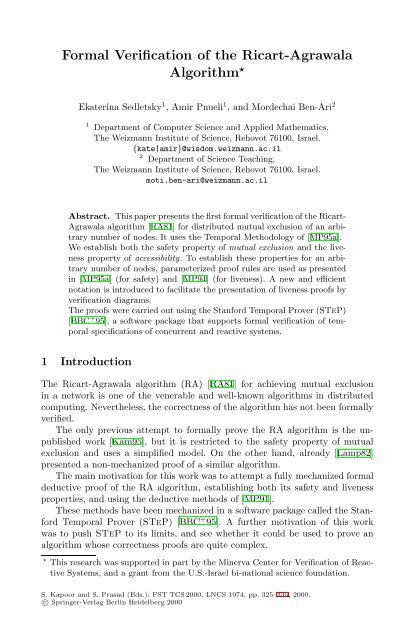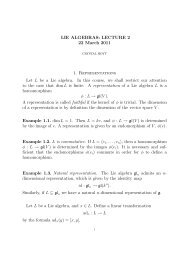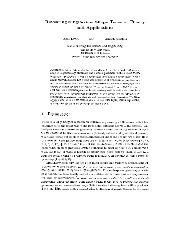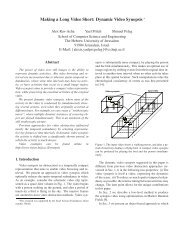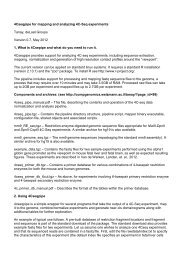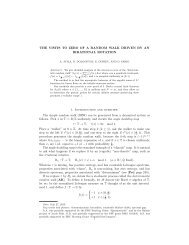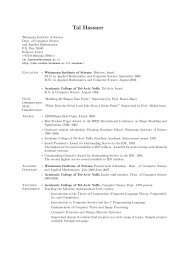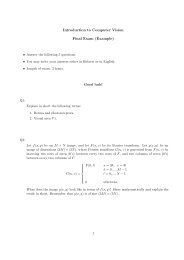Formal Verification of the Ricart-Agrawala Algorithm - Faculty of ...
Formal Verification of the Ricart-Agrawala Algorithm - Faculty of ...
Formal Verification of the Ricart-Agrawala Algorithm - Faculty of ...
Create successful ePaper yourself
Turn your PDF publications into a flip-book with our unique Google optimized e-Paper software.
<strong>Formal</strong> <strong>Verification</strong> <strong>of</strong> <strong>the</strong> <strong>Ricart</strong>-<strong>Agrawala</strong><br />
<strong>Algorithm</strong> ⋆<br />
Ekaterina Sedletsky 1 ,AmirPnueli 1 , and Mordechai Ben-Ari 2<br />
1 Department <strong>of</strong> Computer Science and Applied Ma<strong>the</strong>matics,<br />
The Weizmann Institute <strong>of</strong> Science, Rehovot 76100, Israel.<br />
{kate|amir}@wisdom.weizmann.ac.il<br />
2 Department <strong>of</strong> Science Teaching,<br />
The Weizmann Institute <strong>of</strong> Science, Rehovot 76100, Israel.<br />
moti.ben-ari@weizmann.ac.il<br />
Abstract. This paper presents <strong>the</strong> first formal verification <strong>of</strong> <strong>the</strong> <strong>Ricart</strong>-<br />
<strong>Agrawala</strong> algorithm [RA81] for distributed mutual exclusion <strong>of</strong> an arbitrary<br />
number <strong>of</strong> nodes. It uses <strong>the</strong> Temporal Methodology <strong>of</strong> [MP95a].<br />
We establish both <strong>the</strong> safety property <strong>of</strong> mutual exclusion and <strong>the</strong> liveness<br />
property <strong>of</strong> accessibility. To establish <strong>the</strong>se properties for an arbitrary<br />
number <strong>of</strong> nodes, parameterized pro<strong>of</strong> rules are used as presented<br />
in [MP95a] (for safety) and [MP94] (for liveness). A new and efficient<br />
notation is introduced to facilitate <strong>the</strong> presentation <strong>of</strong> liveness pro<strong>of</strong>s by<br />
verification diagrams.<br />
The pro<strong>of</strong>s were carried out using <strong>the</strong> Stanford Temporal Prover (STeP)<br />
[BBC + 95], a s<strong>of</strong>tware package that supports formal verification <strong>of</strong> temporal<br />
specifications <strong>of</strong> concurrent and reactive systems.<br />
1 Introduction<br />
The <strong>Ricart</strong>-<strong>Agrawala</strong> algorithm (RA) [RA81] for achieving mutual exclusion<br />
in a network is one <strong>of</strong> <strong>the</strong> venerable and well-known algorithms in distributed<br />
computing. Never<strong>the</strong>less, <strong>the</strong> correctness <strong>of</strong> <strong>the</strong> algorithm has not been formally<br />
verified.<br />
The only previous attempt to formally prove <strong>the</strong> RA algorithm is <strong>the</strong> unpublished<br />
work [Kam95], but it is restricted to <strong>the</strong> safety property <strong>of</strong> mutual<br />
exclusion and uses a simplified model. On <strong>the</strong> o<strong>the</strong>r hand, already [Lamp82]<br />
presented a non-mechanized pro<strong>of</strong> <strong>of</strong> a similar algorithm.<br />
The main motivation for this work was to attempt a fully mechanized formal<br />
deductive pro<strong>of</strong> <strong>of</strong> <strong>the</strong> RA algorithm, establishing both its safety and liveness<br />
properties, and using <strong>the</strong> deductive methods <strong>of</strong> [MP91].<br />
These methods have been mechanized in a s<strong>of</strong>tware package called <strong>the</strong> Stanford<br />
Temporal Prover (STeP) [BBC + 95]. A fur<strong>the</strong>r motivation <strong>of</strong> this work<br />
was to push STeP to its limits, and see whe<strong>the</strong>r it could be used to prove an<br />
algorithm whose correctness pro<strong>of</strong>s are quite complex.<br />
⋆ This research was supported in part by <strong>the</strong> Minerva Center for <strong>Verification</strong> <strong>of</strong> Reactive<br />
Systems, and a grant from <strong>the</strong> U.S.-Israel bi-national science foundation.<br />
S. Kapoor and S. Prasad (Eds.): FST TCS 2000, LNCS 1974, pp. 325–335, 2000.<br />
c○ Springer-Verlag Berlin Heidelberg 2000
326 Ekaterina Sedletsky, Amir Pnueli, and Mordechai Ben-Ari<br />
We successfully generated formal pro<strong>of</strong>s <strong>of</strong> both mutual exclusion and accessibility<br />
using STeP. This research points <strong>the</strong> way for fur<strong>the</strong>r improvements both<br />
in pro<strong>of</strong> techniques and in s<strong>of</strong>tware support for deductive verification methods.<br />
2 Implementation <strong>of</strong> <strong>the</strong> <strong>Ricart</strong>-<strong>Agrawala</strong> <strong>Algorithm</strong><br />
To verify <strong>the</strong> RA algorithm, we have written it in a formal programming notation,<br />
<strong>the</strong> language SPL which is used in [MP91] as <strong>the</strong> programming language<br />
(Figure 1).<br />
in N : integer where N ≥ 2<br />
local chq, chp : array [1..N, 1..N] <strong>of</strong> channel [1..] <strong>of</strong> integer<br />
where chq = Λ, chp = Λ<br />
y, z : [1..N] where y=1<br />
type Nar = array [1..N] <strong>of</strong> integer<br />
Bar = array [1..N] <strong>of</strong> boolean<br />
value mini : Nar × Bar → [1..N]<br />
⎡<br />
⎤<br />
local osn, hsn,p,c : integer where osn =0, hsn =0,c=0,p=1<br />
rcs : boolean where rcs = F<br />
rd : array [1..N] <strong>of</strong> boolean where rd = F<br />
⎡<br />
⎤<br />
loop forever do<br />
⎡<br />
⎤<br />
m 1 : noncritical<br />
m 2 : 〈rcs := T ; osn := hsn +1;c := N-1; p := 1;<br />
y := mini(osn, rcs)〉<br />
m 31 : while p ≤ N do<br />
M ::<br />
m 32 : 〈if p ≠ s <strong>the</strong>n chq[s, p] ⇐ osn; p := p +1〉<br />
m 4 : await c=0<br />
m N 5 : critical<br />
⎢ ⎢ m 6 : 〈rcs := F ; p := 1; y := mini(osn, rcs)〉<br />
⎥ ⎥<br />
|| Node[s] ::<br />
⎣ ⎣<br />
m 71 : while p ≤ N do<br />
⎦ ⎦<br />
s=1<br />
m 72 : 〈if rd [p] <strong>the</strong>n [rd [p] :=F ; chp[s, p] ⇐ 1]; p := p +1〉<br />
||<br />
⎡<br />
⎤<br />
local rq : integer<br />
loop forever do<br />
N 〈 ⎡ ⎤<br />
chq[t, s] ⇒ rq<br />
〉<br />
Q :: ||<br />
t=1 ⎢ ⎢ if hsn < rq <strong>the</strong>n hsn := rq ⎥<br />
⎣ q 1 :<br />
⎥<br />
⎣ if (rq,t) ≺ (osn,s) ∨¬rcs<br />
⎦ ⎦<br />
<strong>the</strong>n chp[s, t] ⇐ 1 else rd [t] :=T<br />
||<br />
⎢<br />
[<br />
]<br />
⎣<br />
N local rp : integer<br />
⎥<br />
⎦<br />
P :: || loop forever do<br />
u=1<br />
r 1 : 〈chp[u, s] ⇒ rp; c := c − 1〉<br />
Fig. 1. Implementation <strong>of</strong> <strong>the</strong> RA algorithm.
<strong>Formal</strong> <strong>Verification</strong> <strong>of</strong> <strong>the</strong> <strong>Ricart</strong>-<strong>Agrawala</strong> <strong>Algorithm</strong> 327<br />
The structure <strong>of</strong> <strong>the</strong> program is as follows: we assume that <strong>the</strong>re are N nodes,<br />
where N is a parameter <strong>of</strong> <strong>the</strong> program which stays fixed during execution. Each<br />
node is a concurrent process: in <strong>the</strong> notation Node[s] ::[...], <strong>the</strong> ellipsis indicates<br />
<strong>the</strong> program text for <strong>the</strong> s’th node and s is <strong>the</strong> index <strong>of</strong> <strong>the</strong> node which may be<br />
referenced within <strong>the</strong> program text. The entire program is N || Node[s], implying<br />
s=1<br />
a concurrent execution <strong>of</strong> all <strong>the</strong> nodes.<br />
The nodes are connected to each o<strong>the</strong>r in a complete graph: <strong>the</strong>re is a pair<br />
<strong>of</strong> uni-directional asynchronous channels connecting each node to every o<strong>the</strong>r<br />
node, where chq is <strong>the</strong> outgoing channel for <strong>the</strong> REQUEST messages and chp<br />
is <strong>the</strong> incoming channel for <strong>the</strong> REPLY messages. The notation for output is<br />
chq[a, b] ⇐ e, meaning that node a sends <strong>the</strong> value <strong>of</strong> expression e to node b<br />
along channel chq, and similarly, chq[a, b] ⇒ x, means that node b removes <strong>the</strong><br />
value coming from a and assigns it to x.<br />
The additional global declarations are discussed below.<br />
The program for process Node is composed <strong>of</strong> three concurrent processes:<br />
– M is <strong>the</strong> main process containing <strong>the</strong> critical section and <strong>the</strong> protocols to<br />
be executed upon entry and exit.<br />
– P is <strong>the</strong> process which receives and counts replies.<br />
– Q is <strong>the</strong> process which receives requests and decides if to reply or to defer<br />
<strong>the</strong> reply.<br />
Note that P and Q are <strong>the</strong>mselves composed <strong>of</strong> concurrent processes, one for each<br />
channel. Within Node[s], process Q[t] (which can also be identified as Q[t, s]) is<br />
responsible for reading messages from channel chq[t, s]. Similarly, process P [u]<br />
(P [u, s]) is responsible for reading messages from channel chp[u, s]. The synchronization<br />
among <strong>the</strong> processes within <strong>the</strong> same node is based on shared variables,<br />
and we use <strong>the</strong> notation , to imply that <strong>the</strong> statements are to be executed<br />
atomically. This can be easily implemented using semaphores. We include <strong>the</strong><br />
assignments c := N-1 and p := 1 within <strong>the</strong> atomic statement <strong>of</strong> line m 2 ,and<br />
p := 1 within line m 6 , to reduce <strong>the</strong> number <strong>of</strong> verification conditions in <strong>the</strong><br />
pro<strong>of</strong> <strong>of</strong> accessibility.<br />
Within each node <strong>the</strong>re are global variables which are shared among <strong>the</strong><br />
processes <strong>of</strong> that node:<br />
– osn - <strong>the</strong> sequence number chosen by <strong>the</strong> node.<br />
– hsn - <strong>the</strong> highest sequence number seen in any request message received by<br />
<strong>the</strong> node.<br />
– rcs - a flag that is true if <strong>the</strong> node is requesting to enter <strong>the</strong> critical section.<br />
– c - a counter <strong>of</strong> <strong>the</strong> number <strong>of</strong> outstanding reply messages.<br />
– rd - an array that lists deferred requests. rd [j] is true when <strong>the</strong> node is<br />
deferring a reply to <strong>the</strong> request from node j.<br />
– p, rp, rq are auxiliary variables and could have been declared as local to <strong>the</strong><br />
processes <strong>of</strong> <strong>the</strong> node.
328 Ekaterina Sedletsky, Amir Pnueli, and Mordechai Ben-Ari<br />
The following variables are not needed by <strong>the</strong> algorithm; <strong>the</strong>y were added to<br />
facilitate <strong>the</strong> pro<strong>of</strong>.<br />
– z is <strong>the</strong> index <strong>of</strong> a generic node, which is used to specify and verify accessibility.<br />
– y is <strong>the</strong> index <strong>of</strong> <strong>the</strong> node with <strong>the</strong> minimal value <strong>of</strong> <strong>the</strong> rank (osn[i],i),<br />
where <strong>the</strong> minimum is taken over all nodes i such that rcs[i] istrue.Ifrcs[i]<br />
are all false, y =1.<br />
– mini(osn, rcs) is a function that computes y, <strong>the</strong> index <strong>of</strong> <strong>the</strong> node with <strong>the</strong><br />
minimal rank.<br />
3 Pro<strong>of</strong> <strong>of</strong> <strong>the</strong> Mutual Exclusion Property<br />
Invariance properties <strong>of</strong> <strong>the</strong> form 0 p, wherep is an assertion (a state formula)<br />
can be verified by <strong>the</strong> invariance rule b-inv, givenby<br />
Rule b-inv I1. Θ → ϕ<br />
I2. ϕ ∧ ρ τ → ϕ ′ For every transition τ ∈T<br />
0 p<br />
where Θ is <strong>the</strong> initial condition and T is <strong>the</strong> set <strong>of</strong> transitions <strong>of</strong> <strong>the</strong> verified system.<br />
An assertion satisfying premises I1 and I2 <strong>of</strong> rule b-inv is called inductive.<br />
In our case, <strong>the</strong> main invariance property is that <strong>of</strong> Mutual exclusion, which<br />
can be specified as<br />
PROPERTY excl: 0<br />
∀i, j :[1..N] :m 5 [i] ∧ m 5 [j] → i = j<br />
Here and below, we use m 5 [i] to denote that process M[i] is currently executing<br />
at location m 5 .<br />
3.1 Bottom Up Assertions<br />
At first we use a bottom-up approach to deduce some simple properties <strong>of</strong> <strong>the</strong><br />
program.<br />
Locations at which rcs =1<br />
PROPERTY rcs range: 0<br />
A first observed property is<br />
(m 31,32,4,5,6 [i] ↔ rcs[i]).<br />
Note, that whenever <strong>the</strong>re is a free index, such as i in <strong>the</strong> above property, <strong>the</strong>re<br />
is an implicit universal quantification, implying that <strong>the</strong> property holds for every<br />
i ∈ [1..N].<br />
Range <strong>of</strong> p[i] The variable p serves as a loop counter for <strong>the</strong> loops at<br />
statements m 31 and m 71 . The upper limit <strong>of</strong> <strong>the</strong>se two loops is N.<br />
PROPERTY p range: 0<br />
(1 ≤ p[i] ≤ N +1− m 32,72 [i])
<strong>Formal</strong> <strong>Verification</strong> <strong>of</strong> <strong>the</strong> <strong>Ricart</strong>-<strong>Agrawala</strong> <strong>Algorithm</strong> 329<br />
This inductive assertion claims that p[i] ≤ N + 1 at all locations, except for<br />
locations m 32 and m 72 , where <strong>the</strong> stronger inequality p[i] ≤ N holds.<br />
The Message Chain Linkage<br />
PROPERTY message chain:<br />
0 ((m 31,32 [i] ∧ p[i] >j)+m 4 [i] ≥ |chq[i, j]| + rd [j, i]+|chp[j, i]|)<br />
Here, |chq[i, j]| and |chp[j, i]| denote <strong>the</strong> sizes <strong>of</strong> <strong>the</strong> buffers <strong>of</strong> <strong>the</strong>se asynchronous<br />
channels. This property states that <strong>the</strong> sum |chq[i, j]| + rd [j, i]+|chp[j, i]| never<br />
exceeds 1, and can be positive only if process M[i]isatlocationm 4 or at locations<br />
m 31,32 with p[i] >j.<br />
The Reply Counter The role <strong>of</strong> <strong>the</strong> counter c[i] istocount<strong>the</strong>number<strong>of</strong><br />
positive replies Node[i] received since it last sent out requests for entering <strong>the</strong><br />
critical section. We would expect that, at any point, <strong>the</strong> value <strong>of</strong> c[i] will equal<br />
<strong>the</strong> number <strong>of</strong> pending replies. This is stated by<br />
PROPERTY c range: 0 (c[i] =<br />
N∑<br />
|chq[i, k]| + rd [k, i]+|chp[k, i]|)+m 31,32 [i] · (N − p[i]+(p[i] >i))<br />
k=1<br />
Nei<strong>the</strong>r <strong>of</strong> properties message chain or c range is inductive by itself. However,<br />
<strong>the</strong>ir conjunction, to which we refer as msg range coun- ter, toge<strong>the</strong>r<br />
with <strong>the</strong> previously established property p range form an inductive assertion.<br />
The Value <strong>of</strong> a Request Message<br />
formulate <strong>the</strong> following property:<br />
As <strong>the</strong> last bottom-up invariant, we<br />
PROPERTY request in channel:<br />
0 (|chq[i, j]| > 0 → head(chq[i, j]) = osn[i])<br />
This property states that if channel chq[i, j] is not empty, <strong>the</strong>n <strong>the</strong> value it<br />
contains is <strong>the</strong> current value <strong>of</strong> osn[i].<br />
3.2 Top Down Assertions<br />
We now move to a set <strong>of</strong> assertions which are derived based on <strong>the</strong> goal we wish<br />
to prove, namely <strong>the</strong> property <strong>of</strong> mutual exclusion.<br />
We start by introducing some definitions:<br />
requested(i, j) : i ≠ j ∧ (m 4,5 [i] ∨ (m 31,32 [i] ∧ p[i] >j))<br />
request received (i, j) :requested(i, j) ∧ |chq[i, j]| =0<br />
granted(i, j) : request received (i, j) ∧ ¬rd [j, i]
330Ekaterina Sedletsky, Amir Pnueli, and Mordechai Ben-Ari<br />
Variable hsn Retains <strong>the</strong> Highest Message Number Seen So Far<br />
The following property states that, after having read <strong>the</strong> recent message from<br />
Node[i], <strong>the</strong> variable hsn[j] (“highest seen”) has a value which is not lower than<br />
osn[i].<br />
PROPERTY hsn highest:<br />
0 (request received (i, j) → osn[i] ≤ hsn[j])<br />
The Implication <strong>of</strong> Node[j] Granting Permission to Node[i] The<br />
following property describes <strong>the</strong> implications <strong>of</strong> a situation in which Node[j] has<br />
granted an entry permission to Node[i] beforeNode[i] exited its critical section:<br />
PROPERTY permitted:<br />
0 (granted(i, j) →¬rcs[j] ∨ (osn[i],i) ≺ (osn[j],j))<br />
Finally, Mutual Exclusion Finally, we establish <strong>the</strong> property <strong>of</strong> mutual exclusion,<br />
specified by<br />
PROPERTY excl: 0 (m 5 [i] ∧ m 5 [j] → i = j)<br />
Fig. 2. Set <strong>of</strong> inductive properties leading to <strong>the</strong> pro<strong>of</strong> <strong>of</strong> Mutual Exclusion. The<br />
labels on <strong>the</strong> dependence edges identify <strong>the</strong> transitions for which <strong>the</strong> verification<br />
<strong>of</strong> <strong>the</strong> higher placed property depends on <strong>the</strong> lower property.
<strong>Formal</strong> <strong>Verification</strong> <strong>of</strong> <strong>the</strong> <strong>Ricart</strong>-<strong>Agrawala</strong> <strong>Algorithm</strong> 331<br />
4 A Pro<strong>of</strong> Rule for Accessibility<br />
Rule p-well For assertions p and q = ϕ 0 ,ϕ 1 [k],...,ϕ m [k],<br />
transitions τ 1 [k], ..., τ m [k] ∈J<br />
a well-founded domain (A, ≻), and<br />
ranking functions δ 0 ,δ 1 [k],...,δ m [k] :Σ ↦→ A<br />
m∨<br />
W 1.<br />
p → ∃k : ϕ j [k]<br />
For i =1..m<br />
W 2. ρ τ [k] ∧ ϕ i [k] →<br />
W 3. ρ τ i<br />
[k] ∧ ϕ i [k] →<br />
W 4.<br />
j=0<br />
m∨<br />
∃u :(ϕ ′ j [u] ∧ δ i[k] ≻ δ ′ j [u]) ∨ (ϕ′ i [k] ∧ δ i[k] =δ ′ i [k])<br />
j=0<br />
m∨<br />
∃u :(ϕ ′ j[u] ∧ δ i [k] ≻ δ ′ j[u])<br />
j=0<br />
ϕ i [k] → En(τ i [k])<br />
p =⇒ 1 q<br />
for every τ ∈T<br />
To verify liveness properties <strong>of</strong> parameterized programs, we can use a fixed<br />
number <strong>of</strong> intermediate formulas and helpful transitions but <strong>the</strong>y may refer to<br />
an additional parameter k which is a process index. A parameterized rule for<br />
proving accessibility properties <strong>of</strong> parameterized systems has been presented in<br />
[MP95b]. However, to verify a complicated system such as <strong>the</strong> RA algorithm, it<br />
was necessary to introduce a new version <strong>of</strong> this rule, which we present here.<br />
To improve readability <strong>of</strong> formulas, we write ρ τ i[k] as ρ τ i<br />
[k]. Rule p-well uses<br />
parameterized intermediate assertion, parameterized helpful transitions, and parameterized<br />
ranking functions. For each i =1, ...m, <strong>the</strong> parameter k in ϕ i [k],<br />
τ i [k], and δ i [k] ranges over some nonempty set, such as [1..N].<br />
The rule traces <strong>the</strong> progress <strong>of</strong> computations from an arbitrary p-state to<br />
an unavoidable q-state. With each non-terminal assertion ϕ i , i>0, <strong>the</strong> rule<br />
associates a helpful transition τ i , such that <strong>the</strong> system is just (weakly fair) with<br />
respect to τ i . Premise W2 requires that <strong>the</strong> application <strong>of</strong> any transition τ to<br />
a state satisfying a non-terminal assertion ϕ i will never cause <strong>the</strong> rank <strong>of</strong> <strong>the</strong><br />
state to increase. Premise W3 requires that if <strong>the</strong> applied transition is helpful<br />
for ϕ i <strong>the</strong>n <strong>the</strong> rank must decrease. Due to <strong>the</strong> well-foundedness <strong>of</strong> <strong>the</strong> ranking<br />
functions, we cannot have an infinite chain <strong>of</strong> helpful transitions, since this will<br />
cause <strong>the</strong> rank to decrease infinitely <strong>of</strong>ten. Premise W4 stipulates that <strong>the</strong> helpful<br />
transition τ i is always enabled on every ϕ i -state. Thus, we cannot have an infinite<br />
computation (which must be fair) which avoids reaching a q = ϕ 0 state.<br />
4.1 Representation by Diagrams<br />
The paper [MP94], introduced <strong>the</strong> graphical notation <strong>of</strong> verification diagrams.<br />
For our application here, verification diagrams can be viewed as a concise and<br />
optimized presentation <strong>of</strong> <strong>the</strong> components appearing in rule p-well. We refer <strong>the</strong>
332 Ekaterina Sedletsky, Amir Pnueli, and Mordechai Ben-Ari<br />
reader to Figure 3 for explanation <strong>of</strong> some <strong>of</strong> <strong>the</strong> main elements which typically<br />
appear in such diagrams.<br />
The diagram contains a node for each assertion ϕ i that appears in <strong>the</strong> rule.<br />
The helpful transition tau i associated with ϕ i is identified by <strong>the</strong> label <strong>of</strong> one<br />
or more directed edges departing from <strong>the</strong> node (labeled by) ϕ i .Thus,in<strong>the</strong><br />
diagram <strong>of</strong> Figure 3, m 2 [z] is identified as <strong>the</strong> transition helpful for assertion<br />
ϕ 13 , and <strong>the</strong> helpful transition for ϕ 10 is q 1 [z,i] even though it labels two edges<br />
departing from ϕ 13 .<br />
The interconnection topology in <strong>the</strong> diagram provides a more specialized<br />
(and efficient) version <strong>of</strong> <strong>the</strong> p-well rule. For a node ϕ i ,letsucc(i) be<strong>the</strong>set<br />
<strong>of</strong> indices <strong>of</strong> <strong>the</strong> nodes which are <strong>the</strong> targets <strong>of</strong> edges departing for ϕ i . Then <strong>the</strong><br />
diagram suggests that, instead <strong>of</strong> proving premises W2 and W3 as <strong>the</strong>y appear<br />
in <strong>the</strong> rule, it is sufficient to prove <strong>the</strong>ir following stronger versions:<br />
U2. ρ τ [k] ∧ ϕ i [k] → ϕ ′ i [k] ∧ δ i[k] =δ ′ i [k] for every τ ∈T<br />
U3. ρ τ i<br />
[k] ∧ ϕ i [k] → ∨<br />
∃u :(ϕ ′ j [u] ∧ δ i[k] ≻ δ ′ j [u])<br />
j∈succ(i)<br />
It is not difficult to see that U2 and U3 imply W2 and W3. For example,<br />
premise U3 for assertion ϕ 6 as implied by <strong>the</strong> diagram is<br />
ϕ 6 [i] ∧ ρ m72<br />
[i] → (ϕ ′ 7 [i] ∧ δ 6[i] ≻ δ ′ 7 [i]) ∨ (ϕ′ 4 [i] ∧ δ 6[i] ≻ δ ′ 4 [i])<br />
The more general notion <strong>of</strong> verification diagrams as presented in [MP94] admits<br />
two types <strong>of</strong> edges, one corresponding to <strong>the</strong> helpful transitions, which are <strong>the</strong><br />
edges present in our diagram. The o<strong>the</strong>r type corresponds to unhelpful transitions.<br />
It is suggested <strong>the</strong>re to use a double line for helpful edges. In our case, we<br />
only need to represent helpful transitions, so we draw <strong>the</strong>m as single lines.<br />
The rule also requires to associate with each non-terminal assertion ϕ i a<br />
ranking function δ i . By convention, whenever a ranking function is not explicitly<br />
defined within a node ϕ i , <strong>the</strong> default value is <strong>the</strong> index <strong>of</strong> <strong>the</strong> node, i.e. δ i = i.<br />
For example, in <strong>the</strong> diagram, δ 13 = 13. However, as we will see below, this is not<br />
<strong>the</strong> end <strong>of</strong> <strong>the</strong> story.<br />
4.2 Encapsulation Conventions<br />
The diagram <strong>of</strong> Figure 3 contains, in addition to basic nodes such as those labeled<br />
by assertions, also compound nodes which are also called blocks. Wemay<br />
refer to compound nodes by <strong>the</strong> set <strong>of</strong> basic nodes <strong>the</strong>y contain. For example,<br />
<strong>the</strong> successor <strong>of</strong> node ϕ 13 is <strong>the</strong> compound node ϕ 31,32 . Compound nodes<br />
may be annotated by λ-declarations, such as <strong>the</strong> compound node ϕ 4..7 , by additional<br />
assertions, such as m 4 [y] forblockϕ 3..7 , or ranking components, such as<br />
(6, −p[i]) for block ϕ 6,7 . There are several encapsulation conventions associated<br />
with compound nodes.<br />
– An edge stopping at <strong>the</strong> boundary <strong>of</strong> a block, is equivalent to individual<br />
edges which reach <strong>the</strong> basic nodes contained in <strong>the</strong> block. Thus, both ϕ 11<br />
and ϕ 12 are immediate successors <strong>of</strong> node ϕ 13 .
<strong>Formal</strong> <strong>Verification</strong> <strong>of</strong> <strong>the</strong> <strong>Ricart</strong>-<strong>Agrawala</strong> <strong>Algorithm</strong> 333<br />
– For each basic node ϕ i , <strong>the</strong> full assertion associated with this node is <strong>the</strong><br />
conjunction <strong>of</strong> all <strong>the</strong> assertions labeling <strong>the</strong> blocks in which <strong>the</strong> basic node<br />
is contained. We denote this full assertion by ̂ϕ i . For example,<br />
̂ϕ 7 = m 4 [z] ∧ (∀j : |chq[z,j]| =0) ∧ m 4 [y] ∧ rd [i, y] ∧ m 71 [i]<br />
– For each basic node ϕ i , <strong>the</strong> full ranking function associated with this node<br />
is <strong>the</strong> left-to-right concatenation <strong>of</strong> all <strong>the</strong> ranking components labeling <strong>the</strong><br />
blocks in which <strong>the</strong> basic node is contained. As <strong>the</strong> rightmost component,<br />
we add i. For example,<br />
δ 7 = (1, −osn[y], −y, 4,c[y], 6, −p[i], 7)<br />
In Figure 3 we present <strong>the</strong> full ranking functions for each <strong>of</strong> <strong>the</strong> nodes alongside<br />
<strong>the</strong> diagram.<br />
Note that whenever we have to compare ranking functions which are lexicographic<br />
tuples <strong>of</strong> different lengths, we add zeroes to <strong>the</strong> right <strong>of</strong> <strong>the</strong> shorter one.<br />
For example, to see that δ 13 ≻ δ 12 , we confirm that (13, 0, 0) ≻ (11, −p[z], 12).<br />
Note also that several components <strong>of</strong> <strong>the</strong> ranking functions are negative.<br />
When STeP is presented with any ranking function, one <strong>of</strong> <strong>the</strong> pro<strong>of</strong> obligations<br />
which are generated require proving that all components are bounded from<br />
below. This has been done for all <strong>the</strong> components present in <strong>the</strong> diagram.<br />
5 Pro<strong>of</strong> <strong>of</strong> Accessibility Property<br />
The property <strong>of</strong> accessibility may be written in <strong>the</strong> form<br />
PROPERTY m2m5: m 2 [z] ⇒ 1<br />
m 5 [z]<br />
where z ∈ [1..N].<br />
5.1 Auxiliary Assertions Needed for <strong>the</strong> Pro<strong>of</strong><br />
A crucial part in <strong>the</strong> pro<strong>of</strong> is <strong>the</strong> computation <strong>of</strong> <strong>the</strong> index <strong>of</strong> <strong>the</strong> process y with<br />
minimal signature. ⎧We define<br />
⎫<br />
y =1 ∧ ∀j : ¬rcs[j]<br />
ismin(osn, rcs,y): ⎪⎩<br />
⎪⎭<br />
∨ rcs[y] ∧ ∀j :(rcs[j] → (osn[y],y) ≺ (osn[j],j))<br />
Thus, y has a minimal signature, if ei<strong>the</strong>r <strong>the</strong>re is no process j with rcs[j]<br />
and <strong>the</strong>n y =1,or<strong>the</strong>reexistssomej with rcs[j] =1andy is such a j with <strong>the</strong><br />
minimal signature. In fact, ra<strong>the</strong>r <strong>the</strong>n defining <strong>the</strong> function mini explicitly, we<br />
inform STeP <strong>of</strong> <strong>the</strong> following axiom:<br />
AXIOM mini: ismin(osn, rcs, mini(osn, rcs)).
334 Ekaterina Sedletsky, Amir Pnueli, and Mordechai Ben-Ari<br />
There were several auxiliary assertions whose invariance was necessary in order<br />
to establish <strong>the</strong> pro<strong>of</strong> obligations generated by STeP, when being presented by<br />
<strong>the</strong> verification diagram <strong>of</strong> Figure 3. We list <strong>the</strong>m below:<br />
rd osn : rd [i, j] → (osn[i],i) ≺ (osn[j],j)<br />
not rd range : m 1,2 [i] ∨ (m 71,72 [i] ∧ p[i] >j) → ¬rd [i, j]<br />
y eq mini : y = mini(osn, rcs)<br />
y is min : ismin(osn, rcs,y)<br />
rd to y : rd [i, y] → m 71,72 [i] ∧ p[i] ≤ y<br />
y not change :(∀j : |chq[z,j]| =0)∧ m 4 [z] ∧ m 2 [s] →<br />
(osn[y],y) ≺ (hsn[s]+1,s)<br />
The last property y not change is very crucial in order to establish that y<br />
can stop being minimal only by retiring on exit from m 6 [y]. In particular, no<br />
newcomer s can execute transition m 2 [s] and become minimal.<br />
Fig. 3. <strong>Verification</strong> Diagram for <strong>the</strong> property m 2 [z] ⇒ 1<br />
m 5 [z].
<strong>Formal</strong> <strong>Verification</strong> <strong>of</strong> <strong>the</strong> <strong>Ricart</strong>-<strong>Agrawala</strong> <strong>Algorithm</strong> 335<br />
5.2 Usage <strong>of</strong> STeP in <strong>the</strong> Pro<strong>of</strong><br />
We used STeP version 1.4 from 2/XI/1999 in our pro<strong>of</strong>. Some modifications<br />
<strong>of</strong> <strong>the</strong> source program were necessary in order for STeP to accept our SPL<br />
program. This version <strong>of</strong> STeP also fails to support lambda-blocks in <strong>the</strong> way<br />
<strong>the</strong>re were used in Figure 3. To overcome this difficulty, we had to feed STeP<br />
with some processed fragments <strong>of</strong> this diagram and <strong>the</strong>n modify manually some<br />
<strong>of</strong> <strong>the</strong> resulting verification conditions. We hope that future versions <strong>of</strong> STeP<br />
will provide direct support <strong>of</strong> lambda-blocks.<br />
In spite <strong>of</strong> <strong>the</strong>se minor inconveniences, we found STeP to be a very powerful<br />
and useful verification system, specially geared to <strong>the</strong> temporal verification <strong>of</strong><br />
complex algorithms such as <strong>the</strong> <strong>Ricart</strong> <strong>Agrawala</strong> algorithm we considered here.<br />
Acknowledgment<br />
We gratefully acknowledge <strong>the</strong> help <strong>of</strong> Nikolaj Bjørner <strong>of</strong> <strong>the</strong> STeP research team<br />
for his advice and for his fast response to our requests for modifications in STeP.<br />
References<br />
[BA90] M. Ben-Ari. Principles <strong>of</strong> Concurrent and Distributed Programming.<br />
Prentice-Hall International, Hemel Hempstead, 1990.<br />
[BBC + 95] N. Bjørner, I.A. Browne, E. Chang, M. Colón, A. Kapur, Z. Manna, H.B.<br />
Sipma, and T.E. Uribe. STeP: The Stanford Temporal Prover, User’s<br />
Manual. Technical Report STAN-CS-TR-95-1562, Computer Science Department,<br />
Stanford University, November 1995.<br />
[Kam95] J. Kamerer. <strong>Ricart</strong> and <strong>Agrawala</strong>’s algorithm.<br />
Unpublished, http://rodin.stanford.edu/case-studies, 9 August 1995.<br />
[Lamp82] L. Lamport An Assertional Correctness Pro<strong>of</strong> <strong>of</strong> Distributed Program.<br />
Science <strong>of</strong> Computer Programming, 2, 3, December 1982, pages 175–206.<br />
[MP91] Z. Manna and A. Pnueli. The Temporal Logic <strong>of</strong> Reactive and Concurrent<br />
Systems: Specification. Springer-Verlag, New York, 1991.<br />
[MP94] Z. Manna and A. Pnueli. Temporal verification diagrams. In T. Ito and<br />
A. R. Meyer, editors, Theoretical Aspects <strong>of</strong> Computer S<strong>of</strong>tware, volume<br />
789 <strong>of</strong> Lect. Notes in Comp. Sci., pages 726–765. Springer-Verlag, 1994.<br />
[MP95a] Z. Manna and A. Pnueli. Temporal <strong>Verification</strong> <strong>of</strong> Reactive Systems: Safety.<br />
Springer-Verlag, New York, 1995.<br />
[MP95b] Z. Manna and A. Pnueli. <strong>Verification</strong> <strong>of</strong> parameterized programs. In<br />
E. Börger, editor, Specification and Validation Methods, pages 167–230.<br />
Oxford University Press, Oxford, 1995.<br />
[RA81] G. <strong>Ricart</strong> and A.K. <strong>Agrawala</strong>. An optimal algorithm for mutual exclusion<br />
in computer networks. Comm. ACM, 24(1):9–17, 1981. Corr. ibid. 1981,<br />
p.581.


